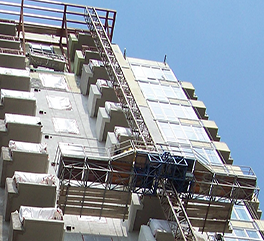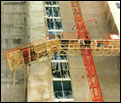Scaffolding eTool
Supported Scaffolds » Mast Climbers

Mast climbing supported scaffolds (mast climbers) carry much heavier loads than traditional scaffolding and are used to position personnel and the necessary tools, equipment, and materials needed to perform work at great heights.
Mast climbers can be free-standing or tied to a structure at intervals for stability at increased heights. The mast may be supported on a stationary base, or for some projects that are lower, on a mobile base. Because mast climbers may be easily adjusted to optimize of working heights, they can reduce the potential for shoulder and lower back injuries to workers. Proper platform positioning reduces material handling hazards and fatigue and improves productivity. Since guardrail systems are built-in, fall protection travels with the platforms. Their small base footprint makes mast climbers very useful on projects with limited space. Mast climbers may be easily customized, and their flexibility gives many trades multiple options for performing work efficiently, in safe and ergonomically correct work conditions.
While there are no OSHA provisions that specifically address mast climbers, they meet the definition of a scaffold in 29 CFR 1926.450(b) and are therefore covered by OSHA’s construction standards in 29 CFR Part 1926, Subpart L, particularly the general requirements in 29 CFR 1926.451. Employers must comply with the general requirements for scaffolds, including capacity, construction, access, loading, clearance from power lines, fall protection, and training.
Mast-Climber Hazards in Construction
- Collapse: Improper Dismantling
Mast climbers have collapsed while being dismantled, causing fatalities. Lack of competent leadership and proper training can result in injuries or fatalities. For instance, mast tie-in removal not done in sequence for disassembly has caused mast climber collapses resulting in fatalities.
- Structural Failure: Overloading
Mast climbers are a popular choice for masonry work because of their ability to lift heavy loads of workers, tools, and materials. They can transport a large supply of mortar, brick, block, masons and helpers to elevation. The machines hold at a precise elevation as the masons work and move properly following each course. However, failing to follow load charts can disastrously overload a mast climber platform, its mast, tie-in braces, and its base or base support level. Overloading mast climbers has been found to have caused structural failures, injuries and deaths.
- Falls: Improper Fall Protection
Falls are one of the leading causes of injuries and fatalities in construction. Although mast climbers include guardrails, sometimes guardrail sections are removed for loading pallets and not replaced. Personal fall arrest or restraint systems must be used when there is a gap in the guardrail system.
OSHA Incident Investigations
- Mast Climbing Scaffold Engineering Investigations and Analyses
The following incidents have been investigated by the Office of Engineering Services in OSHA’s Directorate of Construction. These investigations and analyses were conducted in compliance proceedings against employers whose employees were injured or killed doing construction work using mast-climbing scaffolds.
- Collapse of a Mast-climbing Work Platform (Scaffold) in Miami, FL. March 4, 1995

The building project under construction was a 31-story condominium complex. Five employees were applying stucco to the fascia walls when the work platform collapsed. The cantilever deck failed and three employees fell about 75 feet and were fatally injured. Two employees sustained minor injuries.
- Investigation of the June 20, 2001 partial collapse of the Mast-climbing Platform (Scaffold) at Cambridge, MA.

A six-story parking garage was under construction. The 55-foot long mast-climbing platform consisted of a 20-foot fixed platform plus extensions on both sides supported in the center by a single mast. Three sections, each 5 feet long, were installed on one side, and four sections were installed on the other side. The side with four sections collapsed and three workers were injured.
- Investigation of the June 10, 2009 Mast-climbing Platform (Scaffold) Collapse in Austin, TX.

A mast-climbing platform partially collapsed at a 21-story concrete framed condominium building under construction. Immediately before the incident, the platform descended from the 13th floor and stopped at the 11th floor where half of the platform suddenly separated from the main frame (motorized unit) and fell to the seventh floor. Three workers were killed.
- Collapse of a Mast-climbing Work Platform (Scaffold) in Miami, FL. March 4, 1995
While proper mast climber operation results in significant increases in safety and productivity, misuse has resulted in catastrophic events with worker fatalities and property damage. Common causes of safety incidents related to mast climber use include:
- Inadequate foundation and site preparation;
- Improper erection, installation, movement and dismantling;
- Inadequate component inspections or improper use (e.g., bent or mismatched components) before erection;
- Placement in prohibited proximity to power lines;
- Exceeding environmental and weather limits;
- Failure to close guardrail systems or use fall arrest or fall restraint systems;
- Failure to install toe-boards or nets, or to stack materials;
- Inadequate pre-shift inspections and improper maintenance;
- Inadequate scaffold erector, dismantler, mover, and maintainer training;
- Inadequate scaffold user training;
- Failure to recognize worksite changes (e.g., new power lines erected by scaffold) and to train workers as a result of the changes;
- Failure to observe workers to ensure knowledge and proficiency in performing their job tasks; and
- Failure to train workers who are new to the tasks or retrain when worker competency is in question.
- Mast-Climbing Scaffold Presentation: Overview PowerPoint

